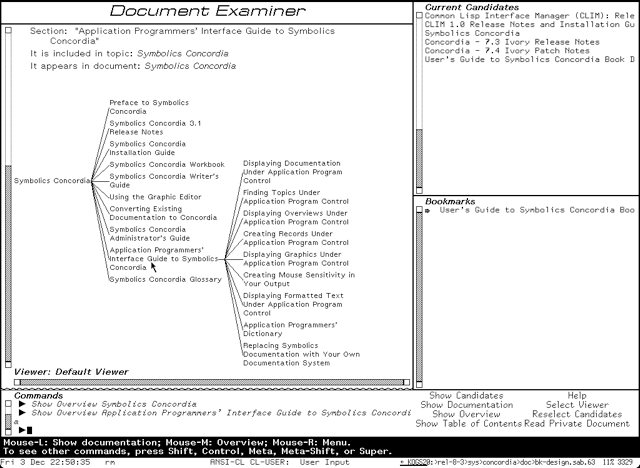The field of online documentation is tackled by Symbolics Inc. Since 1985 the entire user manual for Symbolics’ workstations has been delivered as an electronic edition. The applications program Document Examiner (cf. 2.1.7) is the browser – the corresponding editor Concordia is used to create a hypertext that consists of approximately 10,000 nodes and 23,000 links. According to Janet Walker, the designer of the system, this size corresponds to about 8,000 pages for a printed edition (Document Examiner: Delivery Interface for Hypertext Documents [Walker 87, p. 307]).
Document Examiner and Concordia are implemented like NoteCards in LISP. This is no surprise, since the entire operating system for the Symbolics LISP Machine is also done in LISP.
2.1.7 Symbolics Document Examiner & Concordia
in Vision and Reality of Hypertext and Graphical User Interfaces
For the first time browsing and authoring hypertext is handled by two different application programs. Symbolics Document Examiner is used for viewing, while Concordia is specialized on authoring Symbolics’ hypertext. The reason might be the kind of text, that is published by Symbolics in hypertext form. As a computer manufacturer they provide the user with documentation for their workstations. And user manuals change reasonable rarely.

Fig. 2.7 Sketches by Ted Nelson for chunk style hypertext, windowing text, and compound hypertext
The architecture of Symbolics’ hypertext seems to be inspired by Doug Engelbart’s NLS and by Ted Nelson’s Xanadu, respectively HES. The basic unit for Symbolics’ hypertext is a record. It has a title and contains the description for a specific topic. Keywords and a oneliner should also be provided by the author. Each record has a unique identifier with the same persistent qualities as the statement identifiers in NLS. The records are stored in a central database on the Symbolics workstation.
Just linking the records would not make up a proper online manual. The experience for such purpose should be founded in the book metaphor. A document-like flow of text is created by assembling a sequence of records into a single window. In Literary Machines Ted Nelson calls this technique compound text; respectively he prefers his newly coined term windowing text [Nelson 93, p. 1/15]. An interconnected network of windowing text documents is called compound hypertext [Ibid., p. 1/16].
The records in Symbolics’ hypertext are glued together by inclusion links. Inclusion and three other forms of linking are explained by Janet Walker in Document Examiner: Delivery Interface for Hypertext Documents [Walker 87, p. 310]:
Inclusion. An inclusion link specifies that the content fields of the record referred to are to be included at that location when a reader is reading the document.
Precis. A precis link specifies that the title and oneliner fields of the record are to be included at the location of the link.
Crossref. The result of a crossreference link is to insert a conventional crossreference at the location of the link, for example, “See the section Combatting Gnats.”
Implicit. As writers create the material, they can enclose the names of some topics in implicit name links.
Symbolics’ hypertext browser Document Examiner divides the screen in four panes. The content area, the Candidates and Bookmarks pane and the command region below.
The content area normally displays the documents, but right now in Fig. 2.8 a graphical overview of the documents is presented.

Fig. 2.8 Symbolics Document Examiner with a diagram displayed in the main content pane. 6 links are currently listed in the Candidates pane (top right), but only one bookmark link. (right).
A click on any link does not immediately jump to the destination; instead the link is added to a list of candidates. Eventually a click on a link in the Candidates pane opens the document in the content area. This behavior has turned out to be useful in the application of online help, because users are looking for information and like to preselect some topics that might solve their problems. The result of search operations is also displayed in the Candidates list.
References to documents can also be saved as bookmarks – a concept also based on the book metaphor. A dedicated Bookmark pane holds the links for later use.
Annotations capabilities are underdeveloped in Symbolics’ hypertext system and call for improvement. All preceding hypertext programs offer an integrated reading and writing environment. But the differentiation between the read-only browser and the editor Concordia has taken the editing features from Document Examiner. Furthermore the concept of annotations fits elegantly into the book metaphor. Janet Walker points out the necessity to integrate annotations with versioning. Annotations need to be maintained for each new release of the user manual in hypertext form [Ibid., p. 321].
Janet Walker nominates a second topic that is of interest for future research. It should be possible to constrain the context for search operations. Readers like to define the boundaries before they start a full-text search or keyword query [Ibid.] (cf. the “7 Issues” by Frank Halasz).
![]() For a free PDF version of Vision and Reality of Hypertext and Graphical User Interfaces (122 pages), send an e-mail to:
For a free PDF version of Vision and Reality of Hypertext and Graphical User Interfaces (122 pages), send an e-mail to:
![]() mprove@acm.org I’ll usually respond within a day. [privacy policy]
mprove@acm.org I’ll usually respond within a day. [privacy policy]